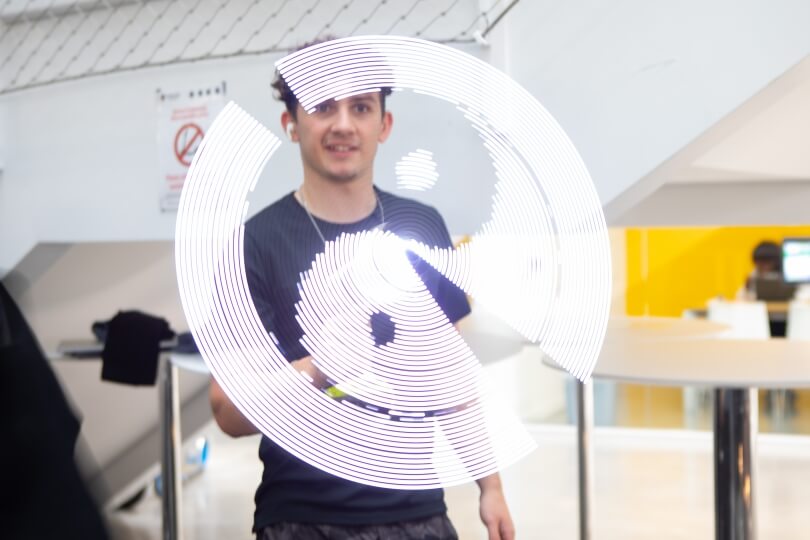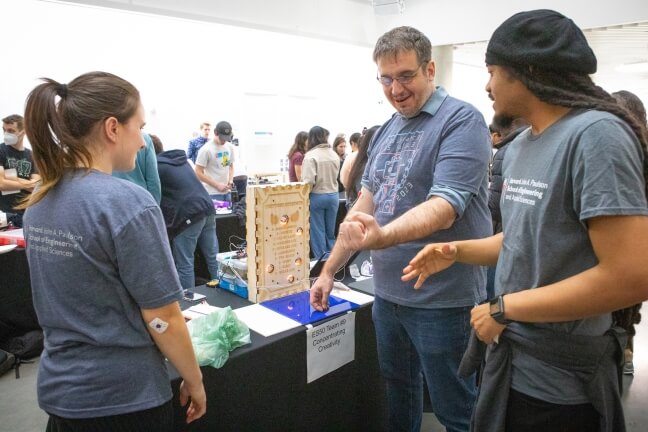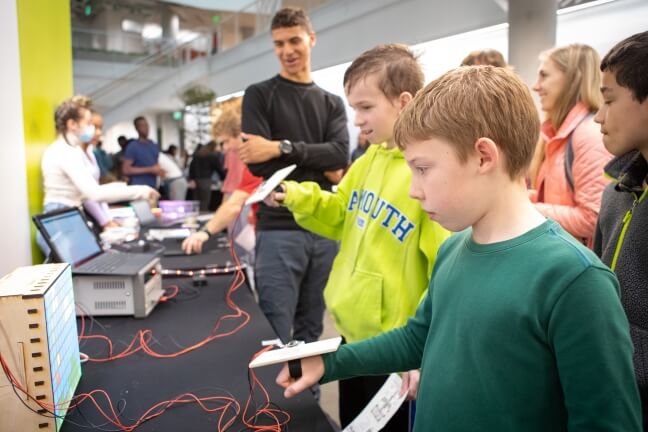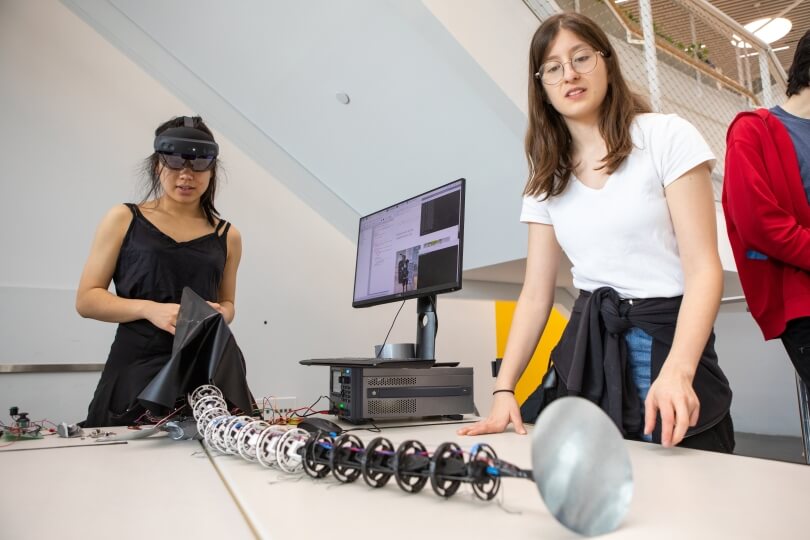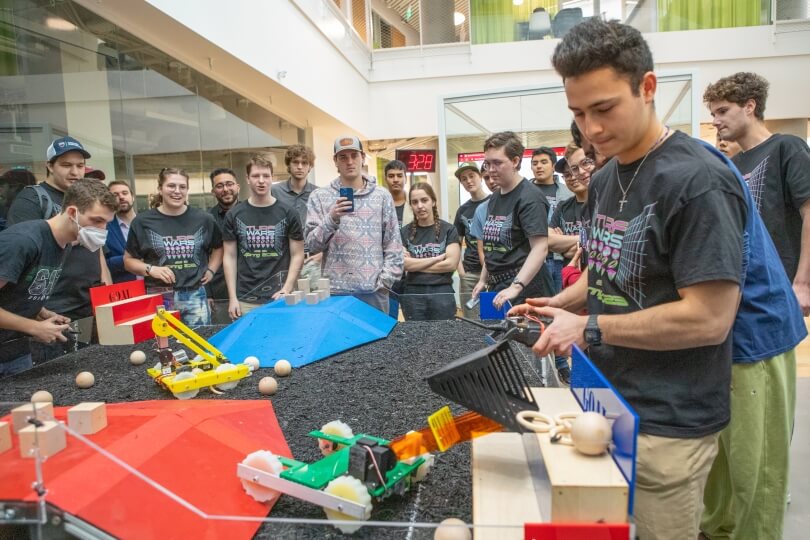News
Steffan Jones projects a yin-yang symbol using a rotating drill and LED lights at the SEAS Design and Project Fair. (Eliza Grinnell/SEAS)
A carnival-like atmosphere greets visitors as they enter the west atrium of the Science and Engineering Complex (SEC). LED lights flash everywhere. Guitar riffs rumble through homemade speakers, right next to a T-shirt that plays drum sounds when you press the different drums printed on it. Visitors can flap handheld sensors to fly a digital bird through an obstacle course or use a joystick to move a metal ball across a Zen sand table.
All these gadgets were designed in “ES50: Introduction to Electrical Engineering.” It’s just one of dozens of Harvard John A. Paulson School of Engineering and Applied Sciences (SEAS) classes and student organizations represented at the SEAS Design and Project Fair, an annual opportunity for visitors to see the true breadth of creativity of the SEAS student body.
“There were a lot of great projects today,” said Natural Premier, a junior studying environmental science and engineering and computer science at SEAS. “We were just having fun with the technology. I’ve seen a lot of these people working really hard on their projects, so seeing them able to show them off to other people is great.”
Premiere’s ES50 project, developed with fellow juniors Sera McDonald (mechanical engineering), Manu Peñéñory (computer science) and Alvin Adjei (biomedical engineering), was called “Test Your Strength.” But instead of trying to ring a bell by slamming a sledgehammer like the classic midway game at carnivals and state fairs, this game uses sensors to measure the electrical signals of a flexing arm muscle. A stronger signal means a higher score and more colorful light show on the electronic display.
Natural Premiere, right, and Manu Peñéñory, left, show off their electronic strength-testing device at the SEAS Design and Project Fair. (Eliza Grinnell/SEAS)
Children move their virtual bird through an obstacle course at the SEAS Design and Project Fair. (Eliza Grinnell/SEAS)
Another classic carnival game, Whack-a-Mole, has an updated, electronic version right next to Premiere’s project. Visitors race to press buttons as soon as they light up on a board before time runs out. With so many visitors, holding the high score throughout the day proves to be quite a challenge.
“I like this environment. I didn’t expect there to be this many people just coming in and checking stuff out,” said Steffan Jones, a sophomore mechanical engineering concentrator. Jones’ project, built with Olivia Berreby (mechanical engineering), Collin Fullen (biomedical engineering), Peter Fischer (mechanical engineering), attached LED light strips to a power drill, which would then spin fast enough to project designs such as a yin-yang or Harvard shield.
Senior capstone project posters fill the main atrium of the SEC, as students get one last chance to show off their year-long research projects before heading downstairs for the awards ceremony. The tables by the SEC Café belong to the student clubs, as virtual reality headsets, robotic limbs, and go-kart frames lay side by side with posters about student-led clean energy initiatives.
LimbX co-creator Alice Cai, left, maneuvers her robotic tentacle arm as co-creator Aida Baradari watches at the SEAS Design and Project Fair. (Eliza Grinnell/SEAS)
“It’s really amazing,” said Aida Baradari, a sophomore studying computer science and physics. “I love that SEAS gives people the opportunity and funding to collaborate. Having students initiate that creativity and giving them the space to do that is great. There are so many amazing things if you walk around. I’m really impressed.”
Baradari’s project is called “LimbX.” It’s a robotic, tentacle-like arm that interfaces with an augmented reality headset worn by co-creator Alice Cai. By looking at a spot on a designated surface and saying “go there,” the arm moves to that spot. Saying “grab that” and “release” activates and deactivates an electromagnet to grab and release objects. Baradari and Cai built the robot from scratch and developed a novel control system integrating eye gaze and voice to explore integration and embodiment of supernumerary limbs. The project involved undergrad and grad students across Harvard and MIT, including: Deepika Gopalakrishnan, Shea Landeene, Xian-Hao Liao, Tushar Kanade, Aryan Naveen, AnhPhu Nguyen, Caine Ardayfio, and Vikram Gupta.
“We chose this continuum form because it’s very different from a human arm, and we want to explore different types of body parts that we’re not used to,” Cai said. “It’s very easy to control a rigid joint robot that moves like a human limb, but a continuously moving robot is more flexible, more versatile, and more interesting to see how it interfaces with a human. We also want to integrate bi-directional haptic feedback and extend it with different functions that humans don’t have, such as a flashlight, camera, or other tool.”
Gabe Twohig, right, drives his robot to victory in the finals of the "Turf Wars" competition at the SEAS Design and Project Fair. (Eliza Grinnell/SEAS)
The lowest level of the SEC belongs to Turf Wars, the final project for “ES51: Computer Aided Machine Design.” A crowd of students gathers around the playing field for the annual robotics competition, cheering and shouting encouragement as teams maneuver their robots around the field, scooping up rings, spheres and blocks and depositing them on platforms to score points.
Led by driver Game Twohig, a sophomore electrical engineering student, The Clouds dominate the day. Their robot’s large bucket easily scoops up multiple objects as it plows across the field, then a long extending arm deposits them all onto the highest-scoring platform. Averaging more than 20 points per round, The Clouds take home the top prize.
“It was a blast,” said Twohig, whose team also included Cole Branca, Meredith Blanchard and Thomas King. “The course itself is basically a manufacturing engineering course. We learned a lot of manufacturing methods, such as CAD, CNC milling, laser-printing or 3D printing. This robot had to meet certain manufacturing requirements, which forced us to implement everything we’d learned in the classroom.”
With so many courses, clubs and projects on display, plus hundreds of students and visitors filling the halls and atria, the SEAS Design and Project Fair makes the SEC feel like what it was always meant to be: not just a place for learning, but a central hub for the entire engineering community to gather, explore, collaborate and create.
Topics: Academics, REEF Makerspace, Computer Science, Design, Electrical Engineering, Materials Science & Mechanical Engineering, Robotics, Student Organizations, Technology
Cutting-edge science delivered direct to your inbox.
Join the Harvard SEAS mailing list.
Press Contact
Matt Goisman | mgoisman@g.harvard.edu
